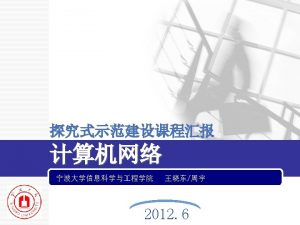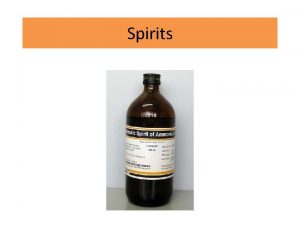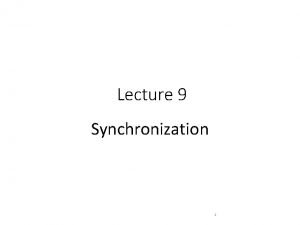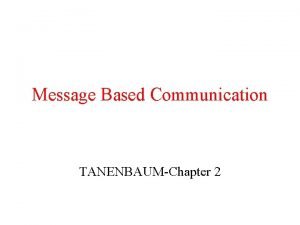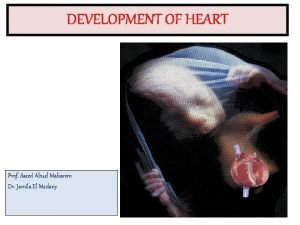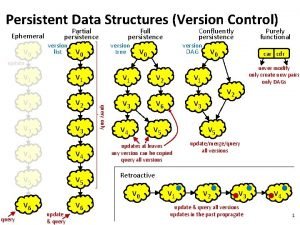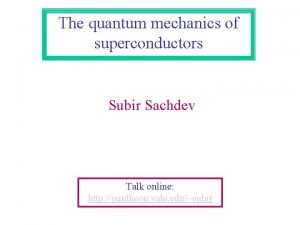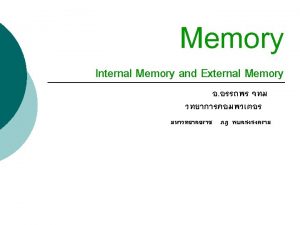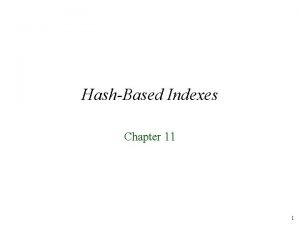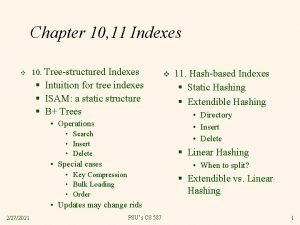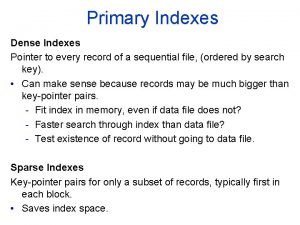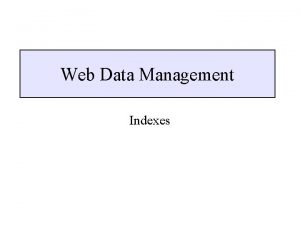Making Volatile Indexes Persistent Using TIPS R Madhava
















































![Discussion ➢ Index conversion techniques q ➢ PRONTO [ASPLOS-20], NVTraverse [PLDI-20], RECIPE [SOSP-19], Linkand-persist Discussion ➢ Index conversion techniques q ➢ PRONTO [ASPLOS-20], NVTraverse [PLDI-20], RECIPE [SOSP-19], Linkand-persist](https://slidetodoc.com/presentation_image_h2/17eaac2776e3c7390f60030423c8b304/image-49.jpg)

- Slides: 50

Making Volatile Indexes Persistent Using TIPS R. Madhava Krishnan, Wook-hee Kim, Hee Won Lee , Minsung Jang , Sumit Monga, Ajith Mathew, Changwoo Min +* †* * The authors contributed to this work while they were at AT&T Labs Research + Consultant † Perspecta Labs

Executive Summary ➢ TIPS is a framework to make volatile indexes persistent ➢ TIPS neither places restrictions on the concurrency model nor requires in-depth knowledge on the volatile index ➢ TIPS guarantees durable linearizability and memory leak free recovery ➢ At its core, TIPS adopts novel DRAM-NVMM tiering approach q Tiered concurrency model for high-performance and scalability q UNO Logging for crash consistency ➢ We converted 7 volatile indexes with different concurrency models and Redis key- value store using TIPS ➢ TIPS outperforms other conversion techniques by at least 3 X and NVMM-optimized indexes by at least 2 X 2

Talk Outline ➢ Motivation ➢ Overview ➢ Evaluation ➢ Conclusion 3

Maturing an Index is Hard! ➢ Indexes are at the core of many storage systems! Numerous Non-Volatile Main Memory (NVMM) optimized Current NVMM-optimized indexes can not be adopted indexes are proposed ➢ into real-world applications without further maturing ➢ Maturing and hardening an index is a demanding task ➢ Recently proposed NVMM-optimized indexes have critical limitations q Weaker consistency guarantee q Not handling persistent memory leaks q Poor concurrency support q Not supporting variable length keys 4

Many Well-engineered DRAM Indexes ➢ There are decades of research on in-memory DRAM indexes ➢ Leveraging the optimized DRAM indexes has several benefits ➢ q A large pool of well-engineered indexes q Paves way for real-world applications to use NVMM Manual Porting of legacy volatile applications are complex and error prone [pmemcached-Hot. Storage 17] It is critical to provide a systematic path to convert DRAM-based indexes for the NVMM 5

Review of Existing Conversion Techniques ➢ Different conversion techniques are proposed based on the concurrency control q NVTraverse [PLDI-20] for lock-free indexes, e. g. , Atomic CAS q PRONTO [ASPLOS-20] for blocking indexes, e. g. , Mutex q RECIPE [SOSP-19] for fine-grained and lock-free indexes Existing Conversion Techniques Have Limited Applicability 6

Review of Existing Conversion Techniques ➢ ➢ RECIPE supports only Buffered Durable Linearizability (BDL) q Durable Linearizability (DL) is the correctness criteria for NVMM q Supporting BDL can result in data loss upon crash q Additional burden to reason about the consistency Other limitations include q Not handling persistent memory leaks [RECIPE, NVTraverse] q In-depth knowledge on the volatile index [RECIPE, NVTraverse] q Can not scale beyond the DRAM capacity [PRONTO] q High crash consistency overhead [PRONTO, NVTraverse] 7

Review of Existing Conversion Techniques Technique Read Concurrency Supported Write Concurrency Supported Applicability Conversion Method Crash Consistency Storage Overhead Consistency Guarantee Memory Leak PRONTO [ASPLOS-20] Blocking Reads Blocking Writes Very limited Indexagnostic Operational logging and snapshots High Durable Linearizability No, uses only DRAM [PLDI-20] blocking Reads blocking Writes (lock-free indexes only) specific updates RECIPE [SOSP-19] Nonblocking Reads Blocking & Nonblocking writes Limited Indexspecific helper mechanism We propose TIPS to (blocking solve these problems and make the overall indexes only) conversion process simple, intuitive and None less error. Durable prone Yes NVTraverse Non. Very limited Index. Lock-free (can’t support blocking indexes) Linearizability None There is no one size fits all technique 8 Buffered Durable Linearizability Yes

Talk Outline ➢ Motivation ➢ Overview ➢ Evaluation ➢ Conclusion 9

Three Main Goals of TIPS 1) Achieve an Index-agnostic Conversion 2) Support Strong Consistency and Correct Recovery 3) High-Performance and Multi-core Scalability 10

Three Main Goals of TIPS 1) Achieve an Index-agnostic Conversion No restrictions on concurrency control of the volatile index Does not require an in-depth knowledge on the volatile index Uniform programming model to hide the complexities 11

Three Main Goals of TIPS 2) Support Strong Consistency and Correct Recovery Supporting Durable Linearizability (DL) for Correctness Guarantee fast and memory leak free recovery Index-agnostic crash consistency with low overhead 12

Three Main Goals of TIPS 3) High-Performance and Multi-core Scalability Perform and scale on-par with NVMM-optimized indexes Preserve and leverage the original characteristics of volatile index Perform better or on-par with index-specific conversion techniques 13

TIPS Architecture DRAM-NVMM Tiering Ø TIPS-Frontend (DRAM + NVMM) q DRAM-cache, an open-chaining hash table containing the recently written key-value pair q Per-thread OLog to guarantee immediate durability for the writes on DRAM-cache Ø TIPS-Backend (NVMM) q User defined index (plugged-in index) on NVMM q ULog to guarantee crash consistent writes to the plugged-in index q MLog to guarantee correct recovery 14

How are the Application Writes Handled? Application Request: Insert (K 1, V 1, f) TIPS-Frontend DRAM-cache DRAM K 0 V 0 K 1 V 1 K 2 V 2 NVMM Durable Linearizability Application Thread (2) Update the DRAM-cache to make the write visible (Linearization Point) Per-thread Operational Log (OLog) … Insert (K 1, V 1, f) Commit-ts = 32 … … Insert (K 2, V 2, f) Commit-ts = 10 … … Insert (K 0, V 0, f) Commit-ts = 18 … (1) Commit and persist the write in OLog (Durability Point) Writes always happen at the fast TIPS-Frontend; Parallel disjoint writes regardless of concurrency model supported by the plugged-in index 15

Three Main Goals of TIPS Achieve an Indexagnostic Conversion Support Strong Consistency and Correct Recovery High-Performance and Multi-core Scalability No restrictions on concurrency control Support Durable Linearizability (DL) Perform and scale on -par with NVMMoptimized indexes No in-depth knowledge required Guarantee correct recovery Preserve the characteristics of volatile index Hiding the programming complexities Index-agnostic crash consistency Perform better than other conversion techniques 16

How are the Application Writes Handled? TIPS-Frontend DRAM-cache K 0 DRAM V 0 NVMM Invalidate the corresponding DRAM-cache K 1 entry V 3 K 1 V 1 K 2 Insert (K 1, V 1, f) Commit-ts = 32 … … … TIPS-Backend V 2 Per-thread Operational Log (OLog) Update (K 1, V 3, f) Commit-ts = 50 … Insert the (K 2, V 2) in the Leaf Node A … Insert (K 0, V 0, f) Commit-ts = 18 Leaf Node A Insert (K , V , f) 2 2 … … Commit-ts = 10 Combine OLog Entries Background thread sorts Olog Backgroundworker combiner thread walks entries in the commit-ts and through all order OLogsofand combines the entries queue entries replay in the per-worker Leaf Node A will be recorded in Mem Log during its allocation K 2 V 2 … … Sort and Replay the OLog Entries (follows the original concurrency model of B+Tree) UNDO Log Leaf Node A before modifying it Leaf Node A UNDO Log (ULOG) Background Worker Thread Plugged-in index (B+Tree) Per-worker Queue … Background Combiner Thread Leaf Node B 17 Leaf Node C … Alloc: Leaf Node A Mem Log (MLOG) …

How are the Application Reads Handled? DRAM-cache Application Request: Lookup (K 1) K 0 V 0 K 1 V 3 DRAM Lookup DRAM-cache for the target key (Lock-free reads) K 1 TIPS-Frontend NVMM Application Thread V 1 Per-thread Operational Log (OLog) … Insert (K 1, V 1, f) Commit-ts = 32 … … Update (K 1, V 3, f) Commit-ts = 50 … … Insert (K 0, V 0, f) Commit-ts = 18 … … … Combine OLog Entries index (B+Tree) DRAM-cache Plugged-in hit: Returns the latest key from the Frontend … Leaf Node A K 2 V 2 … UNDO Log (ULOG) Leaf Node A Leaf Node B 18 Leaf Node C TIPS-Backend Alloc: Leaf … … Node A Mem Log (MLOG)

How are the Application Reads Handled? TIPS-Frontend DRAM-cache Application Request: Lookup (K 2) DRAM K 0 DRAM-cache V 0 Lookup for the target key (Lock-free reads) K 1 V 3 K 1 NVMM Application Thread V 1 DRAM-cache miss: Traverse the B+Tree Per-thread Operational Log (OLog) Insert (K 1, V 1, f) Commit-ts = 32 Update (K 1, V 3, f) Commit-ts = 50 Insert (K 2, V 2, f) Commit-ts = 10 Insert (K 0, V 0, f) Commit-ts = 18 Combine OLog Entries DRAM-cache miss: index Returns Plugged-in (B+Tree) the latest key from the TIPS-Backend Retrieves the Key from the B+Tree Follows the read concurrency model of the B+Tree … Leaf Node A K 2 V 2 … UNDO Log (ULOG) Leaf Node A Leaf Node B 19 Leaf Node C Alloc: Leaf … … Node A Mem Log (MLOG)

Tiered Concurrency Model Ø Two different levels of concurrency in the TIPS architecture ➢ TIPS-Frontend ➢ Concurrency model of DRAM-cache ➢ DRAM-cache supports concurrent reads and disjoint concurrent writes ➢ All writes and reads hitting DRAM-cache will follow this concurrency model ➢ TIPS-Backend ➢ Concurrency model of the plugged-in index ➢ Reads missing DRAM-cache and scans will follow this concurrency model 20

Key Benefits of Tiered Concurrency Model ➢ No restrictions on concurrency model of the plugged-in index q ➢ Good write scalability with a fast and highly concurrent frontend q ➢ Allows plugged-in index to co-exist with the DRAM-cache Even the index with blocking concurrency (e. g. , Mutex) can benefit Relying on plugged-in index i. e. , TIPS-Backend for read performance q Reduces the DRAM footprint q Provides high-capacity scaling q Leverage the original characteristics of the plugged-in index 21

Three Main Goals of TIPS Achieve an Indexagnostic Conversion Support Strong Consistency and Correct Recovery High-Performance and Multi-core Scalability No restrictions on concurrency control Support Durable Linearizability (DL) Perform and scale on -par with NVMMoptimized indexes No in-depth knowledge required Guarantee correct recovery Hiding the programming complexities Index-agnostic crash consistency 22 Preserve and leverage the characteristics of volatile index Perform better than other conversion techniques

Converting a Volatile Hash Table Using TIPS Volatile open-chaining hash table Applying TIPS Plug-in APIs void hash_insert(hash_t *hash, key_t key, val_t value) { node_t **pprev_next, *node, *new_node; int bucket_idx; pthread_rwlock_wrlock(&hash->lock); // Find a node in a collision list bucket_idx = get_bucket(key); node = hash->buckets[bucket_idx]->head; pprev_next = &hash->buckets[bucket_idx]->head; while (node && node->key < key) { pprev_next = &node->next; node = node->next; } // Case 1: update an existing key if (node->key == key) { node->value = value; goto unlock_out; } // Case 2: add a new key new_node = malloc (sizeof(*new_node)); new_node->key = key; new_node->value = value; new_node->next = node; *pprev_next = new_node; // then update then the node unlock_out: pthread_rwlock_unlock(&hash->lock); } 23 Non-Volatile open-chaining hash table using TIPS void hash_insert(hash_t *hash, key_t key, val_t value) { node_t **pprev_next, *node, *new_node; int bucket_idx; pthread_rwlock_wrlock(&hash->lock); Replace the memory allocation/free with tips_alloc or tips_free // Find a node in a collision list bucket_idx = get_bucket(key); node = hash->buckets[bucket_idx]->head; pprev_next = &hash->buckets[bucket_idx]->head; while (node && node->key < key) { pprev_next = &node->next; node = node->next; } // Case 1: update an existing key if (node->key == key) { // Before modifying the value, backup the old value tips_ulog_add(&node->value, sizeof(node->value)) node->value = value; goto unlock_out; } // Case 2: add a new key // Allocate a new node using tips_alloc new_node = tips_alloc (sizeof(*new_node)); new_node->key = key; new_node->value = value; new_node->next = node; // Before modifying the value, backup the old value tips_ulog_add(pprev_next, sizeof(*pprev_next)) *pprev_next = new_node; // then update then the node Add tips_undo_add before modifying the NVMM address unlock_out: pthread_rwlock_unlock(&hash->lock); }

Plug-in Programming Model To access the plugged-in index TIPS Facade APIs API Description bool tips_insert(void *ds, key_t k, val_t v, fn_insert_t *f) Insert a key into the TIPS enabled index bool tips_update(void *ds, key_t k, val_t v, fn_update_t *f) Update a key in the TIPS enabled Index bool tips_delete(void *ds, key_t k, fn_delete_t *f) Delete a key in the TIPS enabled index val_t *tips_lookup(void *ds, key_t k, fn_lookup_t *f) Lookup a key in the TIPS enabled index val_t *tips_scan(void *ds, key_t k, int range, fn_scan_t *f) Scan a key range in the TIPS enabled index TIPS Plug-in APIs API Description bool tips_ulog_add(void *addr, size_t size) Add the given address into the UNDO Log void *tips_alloc(size_t size) Allocate a block of memory from the NVMM heap void tips_free(void *addr) Free the allocated memory from the NVMM heap To modify the plugged-in index 24

Three Main Goals of TIPS Achieve an Indexagnostic Conversion Support Strong Consistency and Correct Recovery High-Performance and Multi-core Scalability No restrictions on concurrency control Support Durable Linearizability (DL) Perform on-par with NVMM-optimized indexes No in-depth knowledge required Guarantee correct recovery Preserve the characteristics of volatile index Hiding the programming complexities Index-agnostic crash consistency Perform better than other conversion techniques 25

Why TIPS-Backend Scalability is Important? ➢ TIPS-Frontend is fast and scalable with concurrent DRAM-cache and per-thread operational logging ➢ Backend writes are inherently slower because of q writes happening in the NVMM q additional logging operations ➢ Slower backend can easily bottleneck the frontend ➢ Fast backend writes can easily keep up with the frontend 26

How TIPS Makes its Backend Scalable? ➢ We introduce two techniques UNO Logging Protocol to Reduce the UNDO Logging Overhead Adaptive Scaling for Concurrent Background Writes 27

UNO Logging Protocol ➢ All three logs (OLog, ULog, MLog) in TIPS works synergistically ➢ TIPS selectively logs the addresses required for the correct recovery in the UNDO log ➢ UNDO logging will be performed only when the requested address ➢ q is not present in the OLog q is not previously UNDO-logged This decision is made using two timestamp information q Time at which the requested address is allocated (alloc-ts) q Time of last OLog reclamation (reclaim-ts) 28

CASE 1: When the Address is not in Any of the Logs reclaim-ts - Timestamp of last OLog reclamation alloc-ts - Timestamp of address allocation Per-thread OLog Background Worker Thread reclaim-ts = 32 … Insert (K 4, V 4, f) Commit-ts = 41 Insert (K 5, V 5, f) Commit-ts = 60 Update (K 3, V 6, f) Commit-ts = 72 Insert (K 7, V 7, f) Commit-ts = 90 … alloc-ts < reclaim-ts The logic to create Node D will not be in the OLog as Node D is allocated before the last OLog reclamation Plugged-in index (Linked List) UNDO Log (ULog) alloc-ts = 5 alloc-ts = 14 alloc-ts = 19 alloc-ts = 27 alloc-ts = 54 K 0 V 0 K 1 V 1 K 2 V 2 K 3 V 3 K 4 V 4 Node A Node B Node C … Node D … 29 Node E

CASE 1: When the Address is not in Any Log reclaim-ts = 32 Per-thread OLog … Insert (K 4, V 4, f) Commit-ts = 41 Insert (K 5, V 5, f) Commit-ts = 60 Update (K 3, V 6, f) Commit-ts = 72 Insert (K 7, V 7, f) Commit-ts = 90 … Check the ULog if Node D is already recorded as result of any Node D is not in ULog so D back it up Modify Node previous writes Plugged-in index (Linked List) UNDO Log (ULog) alloc-ts = 5 alloc-ts = 14 alloc-ts = 19 alloc-ts = 27 alloc-ts = 54 K 0 V 0 K 1 V 1 K 2 V 2 K 3 V 3 K 4 V 4 Node A … Node B Node C Node D … Node D 30 Node E

CASE 1: When the Address is not in Any Log reclaim-ts = 32 Per-thread OLog … Insert (K 4, V 4, f) Commit-ts = 41 Insert (K 5, V 5, f) Commit-ts = 60 Update (K 3, V 6, f) Commit-ts = 72 Insert (K 7, V 7, f) Commit-ts = 90 … Node D is neither in OLog or ULog, so UNDO logging is necessary in this case Plugged-in index (Linked List) alloc-ts = 5 alloc-ts = 14 alloc-ts = 19 alloc-ts = 27 alloc-ts = 54 K 0 V 0 K 1 V 1 K 2 V 2 K 3 V 3 K 4 V 4 Node A UNDO Log (ULog) … Node B Node C Node D … Node D 31 Node E

CASE 2: When the Address is in OLog reclaim-ts = 32 Per-thread OLog … Insert (K 4, V 4, f) Commit-ts = 41 Insert (K 5, V 5, f) Commit-ts = 63 Update (K 3, V 6, f) Commit-ts = 72 Insert (K 7, V 7, f) Commit-ts = 90 … alloc-ts > reclaim-ts The logic to create Node E will be in the OLog as it is allocated after the last OLog reclamation Plugged-in index (Linked List) UNDO Log (ULog) alloc-ts = 5 K 0 V 0 K 1 V 1 Node A … Skip the UNDO for Node alloc-ts = 19 E and alloc-ts = 14 Logging modify it Node B K 2 V 2 Node C 32 alloc-ts = 54 alloc-ts = 99 K 3 V 3 K 4 V 4 K 5 V 5 Node D … Node D alloc-ts = 27 Node E Node F

CASE 3: When the Address is in ULog reclaim-ts = 32 Per-thread OLog … Insert (K 4, V 4, f) Commit-ts = 41 Insert (K 5, V 5, f) Commit-ts = 63 Update (K 3, V 6, f) Commit-ts = 72 Insert (K 7, V 7, f) Commit-ts = 90 … alloc-ts < reclaim-ts The logic to backed create Node will in UNDO the OLog Node D is already up in. Dthe sonot skipbethe Logging Plugged-in index (Linked List) UNDO Log (ULog) alloc-ts = 5 alloc-ts = 14 alloc-ts = 19 alloc-ts = 27 alloc-ts = 54 alloc-ts = 99 K 0 V 0 K 1 V 1 K 2 V 2 K 3 V 3 K 4 V 4 K 5 V 5 Node A … Node B Node C Node D … Node D 33 Node E

CASE 3: When the Address is in ULog reclaim-ts = 32 Per-thread OLog … Insert (K 4, V 4, f) Commit-ts = 41 Insert (K 5, V 5, f) Commit-ts = 63 Update (K 3, V 6, f) Commit-ts = 72 Insert (K 7, V 7, f) Commit-ts = 90 … Modify Node D Using ULog in synergy with OLog can reduce the overhead significantly V -> V 3 Plugged-in index (Linked List) UNDO Log (ULog) 6 alloc-ts = 5 alloc-ts = 14 alloc-ts = 19 alloc-ts = 27 alloc-ts = 54 alloc-ts = 99 K 0 V 0 K 1 V 1 K 2 V 2 K 3 V 6 K 4 V 4 K 5 V 5 Node A … Node B Node C Node D … Node D 34 Node E

Benefits of UNO Logging ➢ Makes the backend writes fast q ➢ Prevents persistent memory leaks q ➢ Addresses in the MLog can be freed upon recovery Reduces crash consistency overhead in the write critical path q ➢ Number of UNDO logging is significantly reduced Using OLog requires only 2 -3 persist barriers UNO logging is index-agnostic q applicable to any index irrespective of type or concurrency control 35

Three Main Goals of TIPS Achieve an Indexagnostic Conversion Support Strong Consistency and Correct Recovery High-Performance and Multi-core Scalability No restrictions on concurrency control Support Durable Linearizability (DL) Perform on-par with NVMM-optimized indexes No in-depth knowledge required Guarantee correct recovery Preserve the characteristics of volatile index Hiding the programming complexities Index-agnostic crash consistency Perform better than other conversion techniques 36

Adaptive Scaling for Concurrent Background Writes ➢ Is merely making backend concurrent enough for performance? ➢ How to determine the number of concurrent workers? ➢ Maintain 1 worker for every foreground writer? ➢ q Idle workers waste CPU cycles and hardware resources q Limits the application from using NUMA socket cores Need to consider the concurrency control of the plugged-in index as well Adaptive Scaling dynamically decides the number of workers. 37

Adaptive Scaling for Concurrent Background Writes ➢ ➢ Key idea is to monitor the frontend and backend write throughput q Try maintaining the throughput ratio = ~1 q Scale up the workers when frontend is faster (i. e. , throughput ratio < 1) q Scale down when the backend is faster (i. e. , throughput ratio > 1) Memorize the best performing worker count while scaling up ➢ once upper bound is reached fall back to the best performing worker count ➢ Adaptive scaling decides the worker count based on the q nature of the workload, e. g. , Write-intensive or read-intensive q write scalability of the plugged-in index 38

Talk Outline ➢ Motivation ➢ Overview ➢ Evaluation ➢ Conclusion 39

Evaluation Questions ➢ ➢ ➢ How much Lo. C are required to convert an index using TIPS? How does TIPS perform against the prior index-specific conversion techniques? How does TIPS perform against the NVMM-optimized indexes? 40

Evaluation Settings ➢ 2 socket server with Intel DCPMM q 512 GB NVMM and 64 GB DRAM q 2. 4 GHZ 64 core Intel Xeon Gold CPU ➢ We evaluate 7 Indexes with different concurrency model ➢ YCSB with 32 M keys for both integer and string type keys Workload Name Read/Write/Scan Ratio Workload Nature Workload A 50/50/0 Write intensive Workload B 95/5/0 Read intensive Workload C 100/0/0 Read only Workload D 95/5/0 Read Latest Workload E 0/5/95 Short Range Scan 41

Evaluation Settings ➢ DRAM-cache size is set to 25% (300 MB) ➢ Compared against the state-of-the-art index conversion techniques ➢ q PRONTO [ASPLOS-20] q NVTraverse [PLDI-20] q RECIPE [SOSP-19] And against NVMM-optimized indexes q Hash Indexes- CCEH [FAST-19], Level. Hashing [OSDI-18], q B+Tree Indexes- Fast. Fair [Fast-18 ], Bz. Tree[VLDB-18] q Radix Tree Indexes- WOART [FAST-17] 42

Lo. C Required for Conversion Indexes Concurrency Control Lo. C change/ original Lo. C Hash Table (HT) Readers-Writer Lock 5/211 Lock-Free Hash Table (LFHT) Non-blocking reads and writes 5/199 Binary Search Tree (BST) Readers-Writer Lock 5/203 Lock-Free Binary Search Tree (LFBST) Non-blocking reads and writes 5/194 B+Tree Readers-Writer Lock 8/711 Adaptive Radix Tree (ART) Non-blocking reads and blocking writes 9/1. 5 k Cache-Line Extensible Hash Table (CLHT) Non-blocking reads and blocking writes 8/2. 8 k Redis Key-value Store Blocking reads and writes 18/10 k TIPS has better applicability and requires minimal code changes in the original codebase 43

TIPS vs PRONTO for Blocking Indexes Readers-Writer Lock B+Tree 10 TIPS 8 q TIPS can support concurrent reads/writes with its DRAM-cache 6 q PRONTO suffers from high synchronization overhead PRONTO Throughput (Mops/Sec) q TIPS outperforms PRONTO by up to 14 X 4 X q Blocking during snapshots 4 14 X 2 0 A B C YCSB Workload D E 44

TIPS vs NVTraverse for Lock-Free Indexes Lock-Free BST TIPS 5 Throughput (Mops/Sec) NVTraverse 4 q NVTraverse incurs 6 and 17 p-barriers for reads and writes ~3 X 3 2 q P_barriers - clwb + sfence q TIPS incurs 3 p-barriers in the write critical path ~2 X q No p-barriers required for reads in TIPS 1 0 A B C D YCSB Workload 45

TIPS vs RECIPE for Fine-grained Locking Indexes TIPS RECIPE-ART WOART Adaptive Radix Tree (ART) Throughput (Mops/Sec) 14 12 10 8 RECIPE-ART supports only a Buffered Durable Linearizability TIPS enabled ART supports Durable Linearizability WOART is single threaded 6 4 2 0 A B C YCSB Workload 46 D E

TIPS vs NVMM-optimized B+Tree Indexes TIPS Fast. Fair Bz. Tree Throughput (Mops/Sec) 10 Fast. Fair has smaller fanout (16) and is designed for cacheline efficiency 8 TIPS-B+Tree has larger fanout (128) hence a better range query performance 6 4 1. 2 X 5 X 2 0 A B C YCSB Workloads D 47 E Index Concurrency Control Fast. Fair Non-blocking reads and blocking writes Bz. Tree Lock-free reads and writes TIPS-B+Tree Readers-Writer Lock

Three Main Goals of TIPS Achieve an Indexagnostic Conversion Support Strong Consistency and Correct Recovery High-Performance and Multi-core Scalability No restrictions on concurrency control Support Durable Linearizability (DL) Perform on-par with NVMM-optimized indexes No in-depth knowledge required Guarantee correct recovery Preserve the characteristics of volatile index Hiding the programming complexities Index-agnostic crash consistency Perform better than other conversion techniques 48
![Discussion Index conversion techniques q PRONTO ASPLOS20 NVTraverse PLDI20 RECIPE SOSP19 Linkandpersist Discussion ➢ Index conversion techniques q ➢ PRONTO [ASPLOS-20], NVTraverse [PLDI-20], RECIPE [SOSP-19], Linkand-persist](https://slidetodoc.com/presentation_image_h2/17eaac2776e3c7390f60030423c8b304/image-49.jpg)
Discussion ➢ Index conversion techniques q ➢ PRONTO [ASPLOS-20], NVTraverse [PLDI-20], RECIPE [SOSP-19], Linkand-persist [ATC-18] Future directions q q Extend the TIPS programming model to support primitive data structures e. g. , stack, queue etc Extend TIPS to support the conversion of distributed index 49

Conclusion ➢ ➢ Current Index conversion techniques q Limited applicability q Weak consistency guarantee q Not address persistent memory leak TIPS q No restrictions on concurrency model q Offers strong consistency i. e. , Durable Linearizability q Fast and correct recovery q In addition to providing an outstanding performance 50
 Persistent vs non persistent http
Persistent vs non persistent http Konda madhava reddy
Konda madhava reddy A logical view of data
A logical view of data Miller indices planes examples
Miller indices planes examples Stoxx blue chip
Stoxx blue chip Scale scores convey more information than index scores.
Scale scores convey more information than index scores. What is security market index
What is security market index Indexes
Indexes Index number in statistics
Index number in statistics Indexes
Indexes Profitability index
Profitability index Sys.partitions
Sys.partitions In a price weighted average stock market indicator series
In a price weighted average stock market indicator series Pharmaceutical uses of volatile oils
Pharmaceutical uses of volatile oils Oleum coriandri
Oleum coriandri Raoult's law and dalton's law
Raoult's law and dalton's law Volatile oils pharmacognosy
Volatile oils pharmacognosy Experiment 5 percent water in a hydrated salt
Experiment 5 percent water in a hydrated salt In-situ soap method of emulsion preparation
In-situ soap method of emulsion preparation Secondary storage provides temporary or volatile storage
Secondary storage provides temporary or volatile storage Is rom volatile or nonvolatile
Is rom volatile or nonvolatile Hydroalcoholic solution of volatile substances
Hydroalcoholic solution of volatile substances Motivation is volatile
Motivation is volatile Volatile c
Volatile c What is volatile oil in pharmacognosy
What is volatile oil in pharmacognosy Read only memory is volatile
Read only memory is volatile Volatile vs atomic java
Volatile vs atomic java Magma volatile gasses definition
Magma volatile gasses definition Arduino fonksiyon tanımlama
Arduino fonksiyon tanımlama Making inferences
Making inferences War making and state making as organized crime
War making and state making as organized crime Atone antonym
Atone antonym Persistent stapedial artery
Persistent stapedial artery Persistent stored modules
Persistent stored modules Pid identifier
Pid identifier Message oriented communication
Message oriented communication Allergies icd 10
Allergies icd 10 Persistent elevation meaning
Persistent elevation meaning Endocardial cushion
Endocardial cushion Rectum parts
Rectum parts Gina guidelines for asthma
Gina guidelines for asthma Processus vaginalis
Processus vaginalis Transient and persistent communication
Transient and persistent communication Specialized cloud architecture
Specialized cloud architecture Session tracking in servlet
Session tracking in servlet Persistent vs ephemeral data structures
Persistent vs ephemeral data structures Pnse persistent non symbolic experience
Pnse persistent non symbolic experience Persistent data container
Persistent data container Persistent currents
Persistent currents Persistent currents
Persistent currents Persistent hyperplastic primary vitreous
Persistent hyperplastic primary vitreous
